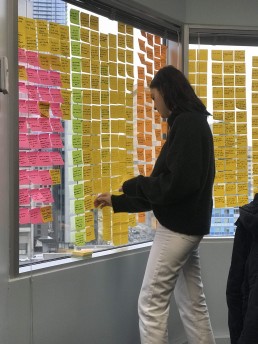Problem Space:
Women’s safety is an issue around the world, but there seems to be a design blind spot in considering women’s specific safety needs. How can we better design solutions that help female-identifying users feel and be safer when walking in their city?
Solution:
Co-Creating Alternative Approaches to Women’s Safety aims to explore how user research and participatory design can offer us multiple solutions to the same problem, in this case, women’s safety while commuting or walking at night. Complex societal issues such as this cannot be solved with one application or tool, but exploration and conversations about the issue leads us to a deeper understanding informed by and made with the people this issue affects daily. The final product is three different tools, made by three different groups of women, each with a different focus and use related to safety in the public space.
Prototype 1: Google Maps Safety Feature
Prototype 2: Urban Planning App
Prototype 3: Emily Carr University Website Safety Page
If any of the prototypes aren’t loading properly, feel free to access them through these links:
Approach:
As project facilitator, I worked with three different groups of women, who collaborated with me during co-creation sessions, probes and interviews to uncover opportunities for new solutions for women’s safety and to start building and designing the features and purposes behind these solutions.
Through three co-creation sessions, we made three different prototypes for possible solutions:
- A Google Maps feature called MoveSafe, that allows users to turn on safe mode that recommends routes with more lights and foot-traffic, as well as an SOS feature and sharing mode where the user can actively share location with their friends.
- A city planning app, which allows users to report safety issues in their community, ranging from a side street that needs lighting to a need for a bus stop somewhere more convenient for solo walkers.
- An institutional solution specific to Emily Carr University, which added a page on the ECUAD website where users could sign up for self defense classes, organize group hikes, and find walking partners for commutes home.
All of these features were discussed and produced collaboratively, and the features within them are informed from insights gained during probe responses, interviews, co-design, and round table conversations. Although I did not plan to have the solutions span from institutional, to local, and global I believe it shows a successful depth of research and communicates the goal of this project to show how important participatory design and research is when addressing complex issues.
Reflection:
I really enjoyed this project, and feel I have accomplished what I wanted to do in terms of co-design and exploration surrounding women’s safety. Over the course of this project I received a lot of positive feedback from the co-designers of co-creations and interviews, as they enjoyed being part of a community of women who were sharing their stories, tools, and techniques they use to feel safe, which is also something I thoroughly enjoyed. One thing I would like to do in future iterations of this project is to expand the co-creation to not just involve women, but other groups that regularly feel unsafe or are often left out of design considerations. Lastly, I would like to work with larger groups of people, which was planned for the project but was cancelled due to the ongoing effects of COVID-19. I am extremely grateful to my co-designer, professors, and peers who gave so much feedback and helped over the course of this project.

About Ginnie
With a passion for user centered research and design, I like to work with methods such as interviews, usability testing, participatory design and surveys, to rapidly prototype and inform product decisions, as well as spur critical thinking about the systems we subscribe to and how they can be re-informed to work better for everyone. I strive to make products and services that are useful, inclusive and accessible to all people.
I recently completed my bachelor’s degree in Interaction Design from Emily Carr University of Art and Design in Vancouver, British Columbia, and I am currently seeking opportunities in qualitative user research, product design, and content strategy or service design.
http://www.ginniemorse.com